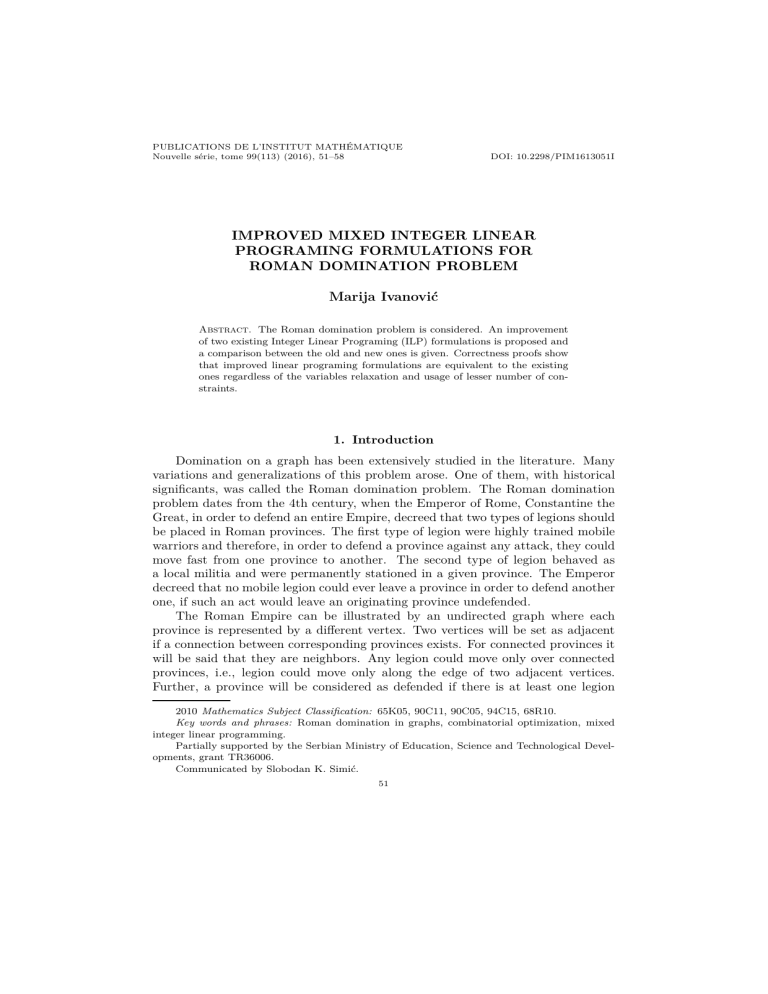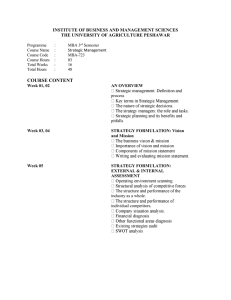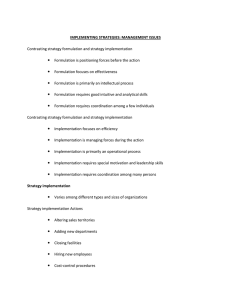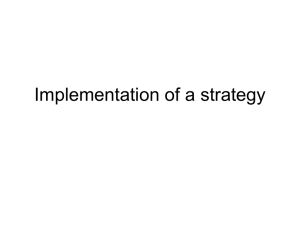PUBLICATIONS DE L’INSTITUT MATHÉMATIQUE Nouvelle série, tome 99(113) (2016), 51–58 DOI: 10.2298/PIM1613051I
advertisement

PUBLICATIONS DE L’INSTITUT MATHÉMATIQUE
Nouvelle série, tome 99(113) (2016), 51–58
DOI: 10.2298/PIM1613051I
IMPROVED MIXED INTEGER LINEAR
PROGRAMING FORMULATIONS FOR
ROMAN DOMINATION PROBLEM
Marija Ivanović
Abstract. The Roman domination problem is considered. An improvement
of two existing Integer Linear Programing (ILP) formulations is proposed and
a comparison between the old and new ones is given. Correctness proofs show
that improved linear programing formulations are equivalent to the existing
ones regardless of the variables relaxation and usage of lesser number of constraints.
1. Introduction
Domination on a graph has been extensively studied in the literature. Many
variations and generalizations of this problem arose. One of them, with historical
significants, was called the Roman domination problem. The Roman domination
problem dates from the 4th century, when the Emperor of Rome, Constantine the
Great, in order to defend an entire Empire, decreed that two types of legions should
be placed in Roman provinces. The first type of legion were highly trained mobile
warriors and therefore, in order to defend a province against any attack, they could
move fast from one province to another. The second type of legion behaved as
a local militia and were permanently stationed in a given province. The Emperor
decreed that no mobile legion could ever leave a province in order to defend another
one, if such an act would leave an originating province undefended.
The Roman Empire can be illustrated by an undirected graph where each
province is represented by a different vertex. Two vertices will be set as adjacent
if a connection between corresponding provinces exists. For connected provinces it
will be said that they are neighbors. Any legion could move only over connected
provinces, i.e., legion could move only along the edge of two adjacent vertices.
Further, a province will be considered as defended if there is at least one legion
2010 Mathematics Subject Classification: 65K05, 90C11, 90C05, 94C15, 68R10.
Key words and phrases: Roman domination in graphs, combinatorial optimization, mixed
integer linear programming.
Partially supported by the Serbian Ministry of Education, Science and Technological Developments, grant TR36006.
Communicated by Slobodan K. Simić.
51
52
IVANOVIĆ
stationed within it. A province without a stationed legion will be considered to
be defended if a vertex which represents it is directly connected to a vertex which
represents a province with two stationed legions: if there are two legions in a
neighbor’s province, one legion will be considered as mobile and therefore, a certain
province will be considered as defended because a mobile legion could arrive fast
in order to defend it. Otherwise a province is left to be undefended. For a detailed
illustration see [8, p. 586].
The proposed problem is illustrated on a small example where the Emperor of
Rome, Constantine the Great, had at his disposal only four legions to be placed
and eight provinces to be defended, see Figure 1.
BRITAIN
GAUL
THRACIA
ITALY
ASIA
MINOR
IBERIA
NORTH AFRICA
EGYPT
Figure 1. Representation of the Roman Empire illustrated on a graph.
Assigning two legions to Italy and another two to Thracia, one province was left
to be undefended. Given that, in order to defend Britain, one mobile legion should
move from Italy to Gaul waiting for another mobile legion to come from Thracia
and then proceed to Britain. It is obvious that such strategy is not optimal, i.e. by
assigning two legions to Iberia and another two to Egypt, the entire Empire will
be defended. The same result could be reached also by assigning two legions to
Britain or to Gaul and another two to Egypt. Note that the minimal number of
legions necessary to defend the given Empire of Rome is four.
The Roman domination problem (RDP), introduced by Ian Stewart in [10],
can be described as a problem of finding the minimal number of legions such that
the entire Empire of Rome is safe.
There are several papers on this problem. The first additional developments
of the RDP were proposed by ReVelle and Rosing in [8], while some of the most
recent theoretical developments were given in [1, 3, 5–7].
Some special classes of graphs, such as interval graphs, intersection graphs,
co-graphs and distance-hereditary graphs can be solved in linear time [5] but, in a
general case, the Roman domination problem is NP-hard, [4, 5, 9].
This paper is organized as follows: the definition of the Roman domination
problem is given in Section 2 and in Section 3, as proposed in the literature, two
IMPROVED MIXED INTEGER LINEAR PROGRAMING FORMULATIONS...
53
existing ILP formulations for solving the Roman domination problem will be reviewed. Subsequently, new alternative formulations together with the proofs of
their correctness will be presented in Section 4. Conclusion, outlook on the future
work and literature are given in the two final sections.
2. Problem definition
Let G = (V, E) represents a finite and undirected graph with a vertex set V such
that each vertex v ∈ V represents a province and each edge, e ∈ E, represents an
existing road between two adjacent provinces. There will be no loops nor multiple
edges between two adjacent vertices. Let us define a neighborhood set Nv (Nv ⊂ V ),
of a vertex v ∈ V , such that each vertex w ∈ Nv is adjacent to a vertex v. Finally,
let us define a function f : V → {0, 1, 2} such that f (v) is equal to a number of
legions assigned to a province represented by a vertex v. Function f has to satisfy
the condition that for every vertex v ∈ V such that f (v) = 0 there exists a vertex
w ∈ Nv such that f (w) = 2. In other words, if there is an undefended province v,
then there exists at least one province w, w ∈ Nv with two stationed legions.
A small illustration of the Roman domination problem follows.
Example 2.1. Let as assume that there are 25 provinces to be defended and
that each province can be represented by a particular vertex of a grid graph G5,5 .
An adjacency matrix of a given graph is defined in such a way that it reflects a
connection between the provinces illustrated on a Figure 2 (left).
1
2
3
4
5
1
2
3
4
5
6
7
8
9
10
6
7
8
9
10
11
12
13
14
15
11
12
13
14
15
16
17
18
19
20
16
17
18
19
20
21
22
23
24
25
21
22
23
24
25
Figure 2. Illustration of Example 1.
The solution to the given problem is illustrated by coloring vertices in three
colors, see Figure 2 (right) and is obtained by mathematical formulations described
in Section 3. The vertices colored in black represent provinces with two assigned
legions, colored in red represent provinces with one legion assigned and colored in
white otherwise. Note that the entire area of 25 provinces could be defended by 14
legions, i.e. f (v2∗ ) = 2 for all v2∗ ∈ {2, 5, 11, 14, 19, 22}, f (v1∗ ) = 1 for all v1∗ ∈ {8, 25}
and f (v0∗ ) = 0 for all v0∗ ∈ {1, 3, 4, 6, 7, 9, 10, 12, 13, 15, 16, 17, 18, 20, 21, 23, 24}.
3. Existing integer linear programing formulations
sec1 There are two ILP formulations known from the literature. The first
formulation was introduced by ReVelle and Rosing in [8] and will be referred to as
54
IVANOVIĆ
RR , while the second formulation was introduced by Burger at el. in [2] and will
be referred to as BVV .
3.1. RR formulation. For a function f , f : V → {0, 1, 2}, and i ∈ V , let us
define the variables
(
(
1, f (i) > 1
1, f (i) = 2
xi =
yi =
0, otherwise
0, otherwise.
The RR formulation of the RDP can be described by
X
X
(3.1)
min
xi +
yi
i∈V
(3.2)
xi +
X
i∈V
yj > 1,
i∈V
j∈Ni
(3.3)
yi 6 xi ,
i∈V
(3.4)
xi , yi ∈ {0, 1},
i∈V
The objective function value, given by (3.1), represents the number of legions
used in defense. Constraints (3.2) ensure that each province is safe or there is at
least one province in its neighborhood with two legions within it. By the constraints
(3.3) it is ensured that provinces with two legions are safe. Decision variables xi
and yi are preserved to be binary by the constraints (3.4).
The RR formulation consists of 2|V | binary variables and 2|V | constraints.
3.2. BVV formulation. For a function f , f : V → {0, 1, 2}, let
(
(
1, f (i) = 2
1, f (i) = 1
yi =
xi =
0, otherwise.
0, otherwise
The BVV formulation of the RDP can now be described by
X
X
(3.5)
min
xi + 2
yi
i∈V
(3.6)
xi + yi +
X
i∈V
yj > 1,
i∈V
j∈Ni
(3.7)
xi + yi 6 1,
i∈V
(3.8)
xi , yi ∈ {0, 1},
i∈V
The objective function value is given by (3.5). By conditions (3.6) it is obtained
that an undefended province has to be in the neighborhood of at least one province
with two assigned legions. By conditions (3.7) it is given that if a province is
defended by two legions then there is no need to say that it is defended by one
legion as well and vice versa. Again, the decision variables xi and yi are preserved
to be binary by the constraints (3.8).
The BVV formulation also consists of 2|V | binary variables and 2|V | constraints.
IMPROVED MIXED INTEGER LINEAR PROGRAMING FORMULATIONS...
55
4. Alternative linear programing formulations
4.1. New improved RR formulation. Let us define
(4.1)
xi ∈ [0, +∞), yi ∈ {0, 1},
i ∈ V.
Considering the RR formulation it can be noted that the binary variables xi
can be relaxed to be real. Let us mark the RR formulation with the given relaxation
(4.1) as RRImp . Given that, the existing RR formulation, which is ILP formulation,
can be relaxed to the MILP RRImp formulation.
Theorem 4.1. Optimal objective function value of the RR formulation (3.1)–
(3.4), is equal to the optimal objective function value of the RRImp formulation (3.1)–
(3.3), (4.1).
Proof. Let a feasible solution to the RRImp formulation be represented by a
vector (x̄′′ , ȳ ′′ ) where x̄′′ = (x′′1 , . . . , x′′n ) and ȳ ′′ = (y1′′ , . . . , yn′′ ), n = |V |. Given
that, let a vector (x̄′ , ȳ ′ ) (x̄′ = (x′1 , . . . , x′n ), ȳ ′ = (y1′ , . . . , yn′ )) of variables x′i and
yi′ be defined such that yi′ = yi′′ for each i ∈ V and
(
0, x′′i ∈ [0, 1)
′
xi =
1, x′′i ∈ [1, +∞).
By this definition, the variables x′i and yi′ have binary values and therefore satisfy
conditions (3.4). Combining the definitions of variables x′′i and binary notation
of variables yi′′ , it follows that yi′ = yi′′ 6 x′′i . Now, if relations yi′′ = 1 stand,
then inequalities 1 6 x′′i imply that x′i = 1 > 1 = yi′ . More, relations yi′′ = 0
provide inequalities 0 6 x′′i , which imply that x′i ∈ {0, 1} > 0 = yi′ for each i ∈ V .
Therefore, conditionsP
(3.3) are satisfied.
Assuming that x′′i + j∈Ni yj′′ > 1, two cases arise:
1) (∃j ∈ Ni ) such that yj′′ = 1,
2) (∀j ∈ Ni ) yj′′ = 0.
P
′
The first case implies that there exists j such that yj′ = 1, i.e.,
j∈Ni yj > 1.
P
P
′
′
′′
′′
Therefore, xi + j∈Ni yj > 1. The second case implies that 1 6 xi + j∈Ni yj = x′′i .
Now, because of x′′i > 1, it follows that x′i = 1. Given that, conditions (3.2) are
satisfied.
Finally, the
P
P objective function value of the RR formulation can be calculated
as i∈V x′i + i∈V yi′ , but because of the relations yi′ = yi′′ and x′i 6 x′′i it is easy
to notice that ObjRR 6 ObjRRImp .
The objective function value of every relaxed minimization problem is less
than or equal to the objective function value of the associated original problem, i.e.
ObjRRImp 6 ObjRR . Finally, combining the given inequalities the theorem is proven,
i.e., ObjRR = ObjRRImp .
From the above it can be noted that 2|V | binary variables of the existing RR
formulation can be replaced with |V | binary and |V | real variables without losing
generality.
56
IVANOVIĆ
4.2. New improved BVV formulations. Considering the BVV formulation
it can be noted that conditions (3.7) can be omitted. Formulation (3.5), (3.6) and
(3.8) will be marked as BVVImp1 .
Moreover, following the idea for improving the RR formulation, the BVVImp1
formulation can be further improved by relaxing binary variables xi to be real.
Such an improvement, (3.5), (3.6) and (4.1), will be marked as BVVImp2 .
Theorem 4.2. Optimal objective function value of the BVVImp1 formulation
(3.5), (3.6) and (3.8) is equal to the optimal objective function value of the BVV
formulation (3.5)–(3.8).
Proof. Let a feasible solution to the BVVImp1 formulation be represented by
a vector (x̄′′ , ȳ ′′ ) where x̄′′ = (x′′1 , . . . , x′′n ), ȳ ′′ = (y1′′ , . . . , yn′′ ), n = |V |. Now, let
us define a vector (x̄′ , ȳ ′ ) of variables x̄′ = (x′1 , . . . , x′n ), ȳ ′ = (y1′ , . . . , yn′ ) such that
yi′ = yi′′ for each i ∈ V . Given that, we can define two disjunctive sets V1 and V2
such that V1 ∪ V2 = V :
1) x′′i = 0 or yi′′ = 0, for each vertex i ∈ V1 ,
2) x′′i = 1 and yi′′ = 1, for each vertex i ∈ V2 .
For each i ∈ V1 , let us define x′i such that x′i = x′′i . By the definition of the
variables x′′i and yi′′ and because (x′i , yi′ ) = (x′′i , yi′′ ), conditions (3.6) and (3.8) are
satisfied. Further, for a given set V1 and because of the binary notations of the
variables x′′i and yi′′ conditions (3.7) are also satisfied:
x′i + yi′ = x′′i + yi′′ 6 max {x′′i , yi′′ } ∈ {0, 1} 6 1.
yi′
x′i
Now, let us define x′i for each i ∈ V2 . Because of the definition of the variables
and set V2 (yi′ = yi′′ and yi′′ = 1), variables x′i will be set to be equal to zero, i.e.
= 0.
Conditions (3.6)–(3.8) are satisfied again:
X
X
x′i + yi′ +
yi′ = 0 + 1 +
yi′′ = 1 + |V2 | > 1,
(∀i) ∈ V2
j∈Ni
j∈Ni
x′i + yi′ = 0 + 1
x′i = 0 ∈ {0, 1},
6 1,
(∀i) ∈ V2
′
yi = 1 ∈ {0, 1}
Therefore, a feasible solution to the BVVImp1 formulation is a feasible solution
to the BVV formulation. The objective function value can be calculated as follows:
ObjBVVImp1 =
X
x′′i + 2
i∈V
=
X
x′′i
+2
=
i∈V1
X
X
x′′i + 2
i∈V1
yi′′
X
yi′′ +
i∈V1
X
x′′i + 2
i∈V2
X
i∈V2
+ 3|V2 |.
i∈V1
x′i + 2
i∈V
X
yi′′ =
i∈V
X
i∈V1
ObjBVV =
X
X
yi′ =
i∈V
x′′i
+2
X
i∈V1
X
x′i + 2
i∈V1
yi′′
+ 2|V2 |.
X
i∈V1
yi′ +
X
i∈V2
x′i + 2
X
i∈V2
yi′
yi′′
IMPROVED MIXED INTEGER LINEAR PROGRAMING FORMULATIONS...
57
It is easy to notice that ObjBVV 6 ObjBVVImp1 .
Now, let us assume that U is a solution set to the BVV formulation. Omitting
condition (3.7) from the BVV formulation, the solution to the BVVImp1 formulation
can be marked as U1 . It is obvious that U ⊆ U1 and therefore, a feasible solution
to the BVV formulation is also a feasible solution to the BVVImp1 formulation. By
the definition of the global and local minimums it implies that
X
X X
X ObjBVVImp1 = min
xi + 2
yi 6 min
xi + 2
yi = ObjBVV
U1
i∈V
i∈V
U
i∈V
i∈V
Finally, combining ObjBVVImp1 > ObjBVV and ObjBVVImp1 6 ObjBVV it implies that
ObjBVVImp1 = ObjBVV .
Theorem 4.3. The optimal objective function value of the BVVImp2 formulation
(3.5), (3.6) and (4.1) is equal to the optimal objective function value of the BVVImp1
formulation (3.5), (3.6) and (3.8).
Proof. Let a feasible solution to the BVVImp2 formulation be represented by
a vector (x̄′′ , ȳ ′′ ), x̄′′ = (x′′1 , . . . , x′′n ), ȳ ′′ = (y1′′ , . . . , yn′′ ), n = |V |. Again, let a vector
(x̄′ , ȳ ′ ) of variables x′i (x̄′ = (x′1 , . . . , x′n )) and yi′ (ȳ ′ = (y1′ , . . . , yn′ )) be defined such
that yi′ = yi′′ for each i ∈ V and
(
0, x′′i ∈ [0, 1)
′
xi =
.
1, x′′i ∈ [1, +∞)
The variables x′i and yi′ have binary values by this definition, therefore they
satisfy conditions (3.8).
P
Assuming that x′′i + yi′′ + j∈Ni yj′′ > 1, two cases arise:
1) (yi′′ = 1) ∨ (∃j ∈ Ni )(yj′′ = 1),
2) (yi′′ = 0) ∧ (∀j ∈ Ni )(yj′′ = 0).
′′
The
exists j such that yj′′ = 1, i.e.
P first′′ case implies that yi = 1 ′ or there
′′
′
, it follows
j∈Ni yjP> 1. Now, knowing that yi = yi and xi > 0 for each i ∈ V
P
′
′
′
that xi +yi + j∈Ni yj > 1. The second case implies that 1 6 x′′i +yi′′ + j∈Ni yj′′ =
x′′i . Now, because x′′iP> 1 it follows that x′i = 1. Further, because yi ∈ {0, 1} it
follows that x′i + yi′ + j∈Ni yj′ > 1 meaning that conditions (3.2) are satisfied also.
function value of the BVVImp1 formulation can be calculated
PNow, the objective
P
as i∈V x′i + 2 i∈V yi′ . Because of the relations yi′ = yi′′ and x′i 6 x′′i it is easy to
notice that ObjBVVImp1 6 ObjBVVImp2 .
Again, knowing that the objective function value of every relaxed minimization
problem is less than or equal to the objective function value of the associated
original problem, it follows that ObjBVVImp2 6 ObjBVVImp1 . Combining the given
inequalities the theorem is proven, i.e. ObjBVVImp1 = ObjBVVImp2 .
yi′′ +
Concerning BVV Imp1 and BVV Imp2 formulations, the number of constraints is
reduced to |V |. Further more, by using BVV Imp2 formulation 2|V | binary variables
are substituted by |V | binary and |V | real variables.
58
IVANOVIĆ
5. Conclusions
This paper is devoted to the Roman domination problem. For the RR mathematical formulation it was proven that from a total of 2|V | variables, |V | variables
can be relaxed to be real. For the BVV mathematical formulation it was proven
that a set of |V | constraints can be excluded. Further more, the number of 2|V |
binary variables of BVV mathematical formulation can be also relaxed to |V | binary
and |V | real variables. While Theorems 4.1–4.3 shows that improved formulations
RRImp , BVVImp1 and BVVImp2 are equivalent to the existing ones, there are significant improvements of the computational efforts for solving these formulations.
Operating with lesser number of constraints and integer variables should provide a memory savings in solving the Roman domination problem on large size
instances. For instance, on Intelr CoreTM i7-4700MQ CPU @ 2.40GHz 2.39GHz
with 8GB RAM under Windows 8.1 operating system and based on the new formulations, standard optimization solver CPLEX was able to find the optimal solution
value on classes of graphs such as grid, net and planar up to 600 vertices.
Designing an exact method using the proposed MILP formulations is a matter
of the future research. Also, in the future work it will be interesting to consider
some variants of the Roman domination problem.
References
1. A. Bouchou, M. Blidia, Criticality indices of roman domination of paths and cycles, Australas.
J. Comb. 56 (2013), 103–112.
2. A. P. Burger, A. P. de Villiers, J. H. van Vuuren, A binary programming approach towards
achieving effective graph protection, Proc. 2013 ORSSA Annual Conf., ORSSA, 2013, pp. 19–
30.
3. V. Currò, The Roman Domination Problem on Grid Graphs, Ph.D. thesis, Università di
Catania, 2014.
4. P. A. Dreyer, Jr., Applications and Variations of Domination in Graphs, Tech. report, 2000.
5. A. Klobučar, I. Puljić, Some results for roman domination number on cardinal product of
paths and cycles, Kragujevac J. Math. 38(1) (2014), 83–94.
6. C. H. Liu, G. J. Chang, Roman domination on strongly chordal graphs, J. Comb. Optim. 26(3)
(2013), 608–619.
7. P. Pavlič, J. Žerovnik, Roman domination number of the cartesian products of paths and
cycles, Electron. J. Comb. 19(3) (2012), p. 19.
8. C. S. ReVelle, K. E. Rosing, Defendens imperium romanum: a classical problem in military
strategy, Am. Math. Mon. 107(7) (2000), 585–594.
9. W. Shang, X. Hu, The roman domination problem in unit disk graphs; in: Computational
Science – Iccs 2007: 7th Internat. Conf., Beijing China, May 27–30, 2007, Proc., Part III,
Lect. Notes Comput. Sci. 4489, Springer, 2007, pp. 305–312.
10. I. Stewart, Defend the roman empire!, Scientific American 281 (1999), 136–138.
Faculty of Mathematics
Department for Applied Mathematics
University of Belgrade
Belgrade
Serbia
marijai@math.rs
(Received 25 03 2015)
(Revised 14 10 2015)







